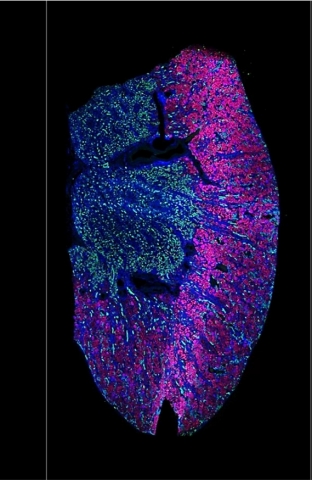
SEATTLE– NanoString Technologies, Inc. (NASDAQ: NSTG), a leading provider of life science tools for discovery and translational research, today announced the launch of the Spatial Organ Atlas, an annotated reference dataset of spatially resolved whole transcriptomes, providing a foundational knowledge base for researchers to quickly discover how organs function in both healthy and disease states, using the GeoMx® Digital Spatial Profiler (DSP).
“The Spatial Organ Atlas maps the whole transcriptomes of the multi-cellular molecular machines that drive organ biology,” said Joseph Beechem, Ph.D., chief scientific officer, NanoString. “For example, we have spatially resolved every major ion transporter system in the kidney, recapitulating 50 years of organ research in a single experiment.”
As part of the Spatial Organ Atlas initiative, whole transcriptome profiles of Formalin-Fixed Paraffin-Embedded (FFPE) tissues were generated from non-diseased organs, using the GeoMx DSP and Whole Transcriptome Atlas (WTA) assays. The initial datasets include spatial transcriptome profiles of biological replicates for six organs, including the human brain, pancreas, kidney, colon, lymph node, and mouse brain. NanoString plans to add data from additional organs over time and intends for this publicly accessible resource to serve as a reference for understanding organ structure and function.
The Spatial Organ Atlas can be explored on NanoString’s website, http://www.nanostring.com/spatial-organ-atlas, through downloadable datasets, including images, sequencing data, and analysis results. In addition, interactive image browsers are provided to narrate whole transcriptome profiling analysis for select organs, beginning with the kidney and pancreas.
“Whole transcriptome profiling of the tubular and glomerular regions in kidney graft biopsies from a patient and normal controls allowed us to unravel previously unappreciated mechanisms of graft response to the alloimmune attack,” wrote Paolo Cravedi, M.D., Ph.D., Department of Medicine, Translational Transplant Research Center, Icahn School of Medicine at Mount Sinai, New York, and his colleagues in their recently published paper entitled, “The spatially resolved transcriptional profile of acute T-cell mediated rejection in a kidney allograft.”
“Spatial whole transcriptome profiles of histological functional units of organs are promising for devising novel therapeutic strategies in many challenging cancers,” said Chris Mason, Ph.D., professor of physiology and biophysics at Weill Cornell Medicine, who is a compensated member of the NanoString Scientific Advisory Board. “There is huge potential for an organ atlas of normal lymph nodes to lay the foundation for improving our understanding of the changes in tumor cells and the local immune response during health and disease, and indeed we have already resolved new pathologies in COVID-19 tissues.” Two recent papers in Nature and Nature Communications by Dr. Mason revealed immune cell infiltration and tissue damage in patient autopsies.
The Spatial Organ Atlas is being highlighted during the 2021 ASHG Conference. Three conference posters and several presentations during NanoString-sponsored events will highlight the latest scientific advances using the GeoMx DSP and the development of NanoString’s Spatial Molecular Imaging (SMI) technology.

